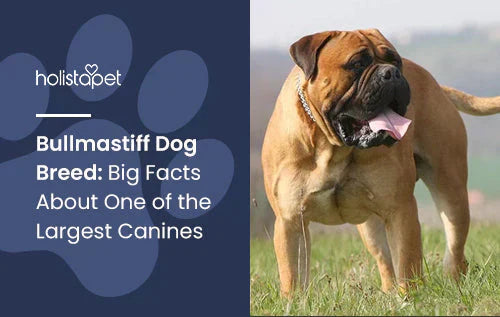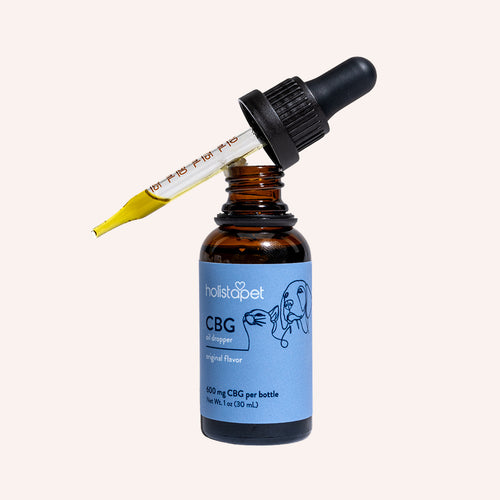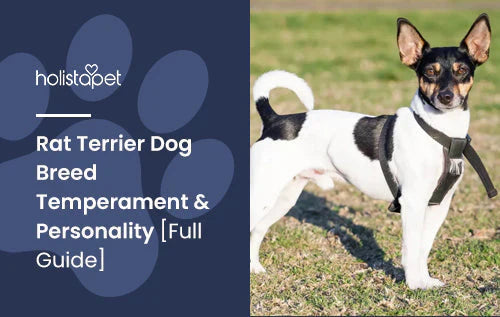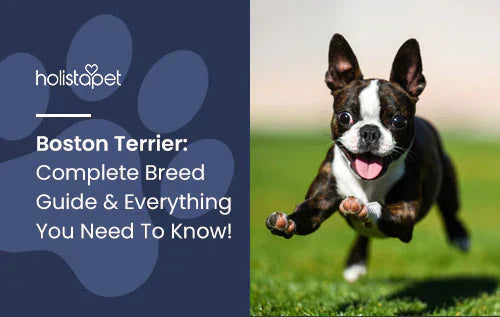The Bullmastiff is a large, powerfully built hound that appears intimidating but is actually a goofball. They're mellow, easy-going dogs who make the perfect addition to any family, especially those with playful kids. If you can handle their size, you'll find a loyal, soft-hearted companion in a Bullmastiff.
Bullmastiff Dog Breed Characteristics
Imposingly vast and muscular, the full grown Bullmastiff need only stand up to send a shiver down the spine of intruders. Their broad heads, dark brown eyes, and deep muzzles combine to portray a distinctly intelligent and bold expression. When they're on alert, the look in their eyes says, "don't even try it."
Despite this somewhat aggressive initial appearance, the Bullmastiff's face softens and scrunches with playful joy whenever they're around their family and friendly strangers. Their high-set, V-shaped ears flop around their wrinkled faces when relaxed and perk when they go into guard-dog mode.
Although they're colossal, the Bullmastiff is relatively lean and agile. Their body weight is mainly comprised of muscle, giving these heavy-boned hounds powerful strength. Originally crossbred to become fearsome guard dogs, the Bullmastiff is always ready to spring into a protective role.
Breed Size
How big do bull mastiffs get? Like many dog breeds, male Bullmastiffs are typically slightly larger than females, though not by much. Males tend to measure 25 to 27 inches at the shoulder and weigh 110 to 130 pounds. Females tend to measure 24 to 26 inches at the shoulder and weigh between 100 to 120 pounds. The biggest Bullmastiff grows exceedingly quickly as a puppy and becomes a gigantic, bumbling adult before you know it. Despite their adult size, they surprisingly adapt pretty well to apartment life as long as they plenty of time outside.

Dog Breed Personality
As they were bred as guard dogs, Bullmastiffs are quite protective of their family and territory. However, they rely on their intimidating appearance and heavy-enough-to-knock-you-over bodies to scare intruders away. Their instinct is to instill fear, not to cause physical harm. Although they have a long history as working guard dogs, these gentle giants are warm and affectionate family dogs. They may be wary of strangers and bark loudly or give chase to perceived threats. But in general, they're overwhelmingly friendly and playful dogs.
The big Bullmastiff is pretty outgoing and brave when they need to be. They can be incredibly adventurous, but at the end of the day, all they want to do is cuddle up with their family on the couch. Despite their sharp instincts, Bullmastiffs are lovably sweet and eager to please - they'll vie for your attention. These massive yet (generally) mellow dogs do just fine on their own while you're at work, but expect them to attach to you the moment you walk in the door at home. Bullmastiffs have a fondness for laying on top of their owners on the couch - at heart, they're a lapdog in a large dog's body.
Whether they're lying on top of you or not, you'll always need to be on the lookout for slobber. The Bullmastiff is an excessive drooler. It's recommended that you keep towels around the house (and in the car when traveling) so you're ready to clean their inevitable wet mess.
Dog Breed Exercise
Although the Bullmastiff big appears to be exceedingly athletic, they're not built for endurance activities. Daily moderate exercise, like brisk walks and playing fetch, is plenty of activity to keep them in good health. Because of their rapid growth as puppies, it's recommended that you moderate their exercise to encourage steady growth.
Bullmastiffs have tons of energy when they're young, and it may seem like letting them run it out is a good idea, but they can be quite prone to injuring themselves at this stage.

As Bullmastiffs get older, some of them turn into couch potatoes while some of them remain balls of energy. No matter their personality, it's crucial to get them up and moving for around an hour every day. Especially since most Bullmastiffs remain sedentary throughout the day while you're gone.
The Bullmastiff does not make a good running partner, but they do love going for walks and patrolling their territory. If you have a yard, you must have a secure fence as the Bullmastiff will chase animals and strangers that they perceive as threatening. They're built to sprint.
Breed Training
Socialization and obedience classes are crucial for the Bullmastiff puppy. It's recommended that you enroll them as soon as you bring them home - building a relationship based on rules and respect is essential to gain their obedience. Their rapid growth makes this training even more essential.
When you bring home a Bullmastiff puppy, you really won't have much time to train them before they become powerful, imposingly large adults. The general rule of thumb with most dog breeds is that if you don't want them doing something as an adult, don't let them do it as puppies.
So, if you don't feel like sharing your couch with 130 pounds of muscular, slobbery dog, don't allow them on the couch when they're cuddly little pups. It's essential to be firm yet kind and encouraging when setting boundaries with your Bullmastiff. They adoration as much as they need structure.
As long as they're adequately socialized and go through obedience training as puppies, Bullmastiffs can excel at following orders. They're excellent trackers and are unsurprisingly agile; since the late 19th century, Bullmastiffs have excelled in the show ring.

Dog Breed History
Before they became show dogs, the Bullmastiff was bred to be a watchful and eerily intimidating guard dog. During the 18060s, poaching was a terrible problem in the English countryside on aristocratic game preserves. Even the harsh penalty of being sent to the gallows wasn't stopping the poachers.
Tired of waiting up all night and chasing off poachers who often brought guns, Gamekeepers knew they needed a canine guardian equipped to help mitigate the poaching. They began breeding Mastiffs and Bulldogs, focusing on their instincts and abilities rather than their looks. Eventually settling around 60% Mastiff and 40% Bulldog, gamekeepers had successfully bred the strong, intuitive, and courageous Bullmastiff. They were wickedly fast and could chase and tackle poachers on pitch-black nights. But the Gamekeepers taught them never to maul, only to detain.
The Bullmastiff quickly became known as "The Gamekeeper's Night Dog." They were menacing enough to scare off or take down dangerous intruders, yet gentle enough that knew not to harm them. Bullmastiffs quickly became beloved and respected family members on the farms. As they grew in numbers and popularity, competition broke out among the gamekeepers and their Bullmastiffs. They all claimed that their Bullmastiff was the strongest, the fastest, and bravest. It didn't take long before they began entering the dogs in agility competitions.

After proving to excel in the show ring, the Bullmastiff was registered as an official breed with the Kennel Club (UK) in 1924. As Americans began importing Bullmastiffs, the American Kennel Club noticed their beauty and performance level and registered the breed in 1933.
Dog Breed Health Problems
Bullmastiffs are unfortunately prone to several genetic conditions that can seriously impact their quality of life. Bloat, hip and elbow dysplasia, and hypothyroidism are common Bullmastiff issues. Despite the concerns, Bullmastiffs have a life span of seven to 10 years.
Bloat
According to the American Kennel Club (AKC), "Bloat, also known as Gastric Dilatation-Volvulus (GDV) complex, is a medical and surgical emergency." Typically occurring after a dog eats, bloat takes the lives of around 30% of the canines it affects. This condition mostly affects large dogs like Mastiffs.
Bloat happens when a dog's stomach begins trapping air and twists inside the abdomen, cutting off the blood supply in the middle of the body. Veterinarians are still unsure which comes first; does the twisting cause air-trapping, or is it the other way around? Either way, it sends the dog into shock. Next, the oxygen-starved pancreas begins releasing hormones so toxic that they can stop a dog's heart. It's an incredibly devastating condition that comes on suddenly and violently. As a Bullmastiff owner, it's crucial that you know the signs of bloat so that you can rush them to treatment right away.
Signs of bloat in dogs include:
- Retching
- Excessive salivation
- Restlessness
- Whimpering when the abdomen is touched
- Noticeable abdominal swelling

Hip and Elbow Dysplasia
Hip dysplasia is a genetic predisposition to malformation of the hip joint as a dog grows. The misalignment of these ball and socket joints causes painful bone-on-bone rubbing, limiting the dog's mobility. Elbow dysplasia is the same, except it affects the radius, ulna, and humerus connection.
The signs of elbow and hip dysplasia are essentially the same as well. The symptoms include:
- Difficulty standing up from laying down
- Reluctance/inability to climb stairs/jump onto the couch
- Leg weakness
- Joint swelling
- Wobbliness
According to the American Bullmastiff Association (ABA) via the American Kennel Club, you should have your Bullmastiff screened for both forms of dysplasia at a very young age. Non-steroidal anti-inflammatory drugs (NSAIDs) are a very effective and unharmful treatment in most cases. Beneficial additives like glucosamine, canine-grade CBD oil, and omega-3 fatty acids may also help, as can modifying your dog's diet and exercise. Left untreated, elbow and hip dysplasia can develop into arthritis.
Hypothyroidism
Hypothyroidism is a condition where the thyroid gland is dangerously underactive, causing a dog's metabolism to slow. According to VCA Hospitals, it's usually caused by lymphocytic thyroiditis (an immune-related disease) or idiopathic thyroid gland atrophy (normal thyroid tissue replaced by fat).

Common symptoms of Hypothyroidism:
- Weight gain that doesn't match food intake
- Intolerance to cold weather
- Dry, dull, excessively shedding hair
- Lethargy
- Darkening pigmentation
- High cholesterol
Less common signs:
- Facial skin thickening
- Leg lameness
- Lack of coordination
Entropion
According to The Spruce Pets, "Entropion in dogs is an ocular condition that causes the eyelids to roll inward." Bullmastiffs are particularly prone to suffering from entropion, which causes the lashes and hair around the eyes to rub and irritate the corneas.
Severe adult entropion can be treated with surgery that reshapes the eyelids. Bullmastiff puppies with entropion can have sutures done to tack back the eyelids. In some cases, Bullmastiff puppies grow out of entropion with the help of this treatment.
Signs of entropion are:
- Eye redness
- Squinting
- Excessive tearing
- Swelling around eyes
- Obvious irritation
- Excessive blinking
How to Care for a Bullmastiff
Bullmastiffs are mellow, low-energy, affectionate dogs that have a protective streak. Bonding with your Bullmastiff is essential - they're sensitive and loving despite their intimidating appearance and need an owner who's willing to give them all the attention they need.

Although they were "The Gamekeepers Night Dog" in the 1800s, today, Bullmastiffs need to live mostly inside. They do enjoy their outdoor time immensely, they just shouldn't be left there unattended for a long time. You'll need a high, sturdy fence around your yard to keep them contained while you play outside.
Because of their calm demeanor and extremely devoted, tender personalities, Bullmastiffs make excellent therapy dogs. They pick up well on emotion even without training and are quick to come to their owners' side and offer comfort when they sense distress.
Nutrition and Feeding for a Bullmastiff
Although most adult Bullmastiffs weigh around 120 pounds, they need less food than you may think. A fully grown Bullmastiff should eat between three and four cups of high-quality, protein-rich food split into two meals per day. Food should not be left out all the time for them to snack on.
Separating your Bullmastiff's food into two meals makes it so they aren't digesting too much at once. Avoiding a digestive overload is a great preventative measure for bloat, as is limiting their mealtime water intake. The most critical aspect of avoiding bloat is not going for walks right after eating.
A Bullmastiff puppy should eat several tiny meals spread throughout the day. Bullmastiffs need to be kept lean in general, but it's even more important during puppyhood for their rapid growth.
To monitor your Bullmastiff's weight without a scale, stand above them and look down - you should see a distinct waist. Then, place your hands on their back with the heels of your palms turned inward and your fingers spread out and down. You should be able to feel their rib cage but not actually see it.

Related: Organic Dog Food Vs Non-Organic [In-Depth Comparison]
Coat Color And Grooming
Although a Bullmastiff makes a mess with their drool, you won't have to worry about that with their coat. Their hair is short and dense, and they generally only shed seasonally. If you notice excessive shedding, it may indicate a health condition related to their nutrition. Although a Bullmastiff's coat doesn't get tangled, they still benefit from brushing two to three times a week.
Regular brushing removes dirt and any excess hair from their coat, which helps to prevent skin infections. Skin infections or irritations can cause loss of hair and unhealthy or dull hair growth. Short-coated dogs like the Bullmastiff should be bathed only as needed, typically every month to month and a half.
Of course, if they get dirty when playing outside or begin to develop a doggy odor, you can and should bath them regardless of when they were last washed. And if you want to promote a shiny coat and nourished skin bathe them with Holistapet's best shampoo for dogs.
Bullmastiffs' standard coat colors are fawn, red, and brindle (a dark, almost-tiger striped pattern). Bullmastiffs with fawn coats almost always have a black mask pattern on their muzzle. Gamekeepers desired Brindle-coated Bullmastiffs since the dark color pattern camouflaged them at night.
Their nails grow quickly and need to be trimmed one to two times per month. To prevent plaque build-up, their teeth should be brushed two to three times a week. It's also important to regularly check your Bullmastiff's ears for excessive wax or the presence of mites.
Related: How to Bathe a Dog: A Step-by-Step Guide for Responsible Owners
Children And Other Pets
Unsurprisingly, the Bullmastiff is an excellent family dog and is wonderful with children. They're jovial, friendly, and affectionate - you might want to prepare kids to be licked incessantly. Additionally, large and powerfully built Bullmastiffs can accidentally knock over small children. Bullmastiffs generally do best with other dogs of the opposite sex, but they can learn to be friendly with almost any dog.
As long as they're adequately socialized from puppyhood, they rarely show aggression toward strange dogs. Unless, of course, that strange dog seems threatening to their family. Surprisingly, Bullmastiffs can do pretty well around brave and curious cats. It's the skittish cats that make them nervous, and they have been known to chase after fleeing felines. If you already have other pets in the house, consider their personalities before deciding to adopt a Bullmastiff.

Breed Organizations
The American Bullmastiff Association (AMA) is the foremost breed organization in the United States. They're dedicated to educating people on the breed as well as the continuation of ethical breeding practices. As we mentioned, they're the official Bullmastiff organization of the American Kennel Club.
The Cascade Northwest Bullmastiff Club (CNBC) is the oldest and most prominent Bullmastiff organization in the Pacific Northwest region. They're focused on educating the public on the Bullmastiff breed and fund research efforts that may benefit Bullmastiffs and other large-breed dogs.
More About This Dog Breed
The Bullmastiff is a multi-faceted dog. One minute they're bounding after a ball, tongue hanging freely out of their playful mouth. The next, they're snoring and drooling on the couch (or on top of you). Then, in the blink of an eye, they turn into threatening guard dogs, ready and able to give chase.
Their diverse personalities make owning a Bullmastiff a constant adventure and sometimes a constant struggle. Some enjoy lollygagging, and some will never settle down after puppyhood. Before adopting one of these wildcard pups, please consider whether or not you can handle their fluctuations.
If you're up to the challenge, all the power to you. Bullmastiffs are incredible and kind beasts and make a fantastic addition to almost any home they join.



 CBD Oil for Dogs - Fast Acting
CBD Oil for Dogs - Fast Acting
 Chicken Flavored CBD Oil For Dogs - Easy Dose
Chicken Flavored CBD Oil For Dogs - Easy Dose
 Salmon Flavored CBD Oil For Dogs - Highly Rated
Salmon Flavored CBD Oil For Dogs - Highly Rated
 CBG Oil for Dogs and Cats - Loved by Thousands
CBG Oil for Dogs and Cats - Loved by Thousands





Leave a comment
All comments are moderated before being published.
This site is protected by hCaptcha and the hCaptcha Privacy Policy and Terms of Service apply.